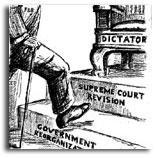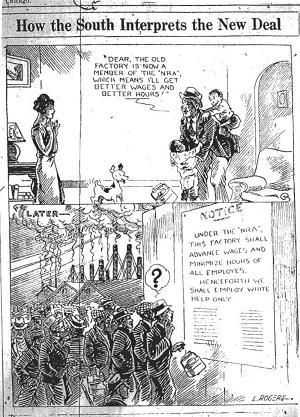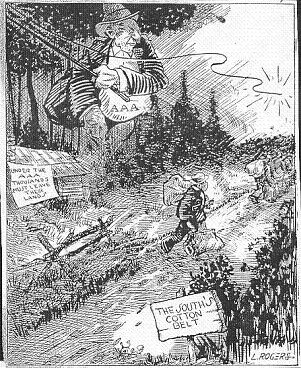|
       
How successful was the New Deal?
|
|
Socialism: If you own two cows you give
one to your neighbour.
Communism: You give both cows to the
government and the government gives you back some milk.
Fascism: You keep both cows, but the
government takes your milk, and sells some of it back to you.
New Deal: You shoot both cows and milk the government.
Republican joke of the 1930s
As with most historical questions, there are two sides to this issue.
On the one hand, it can be argued that the New Deal was a success (the
5Rs).
On the other hand, there are many arguments that it had serious weaknesses and failings (the
3Ds).
* * * * *
|
Going Deeper
The following links will help you widen your knowledge:
Basic accounts from
BBC Bitesize
Excellent overviews from Social Studies Help -
impact/
challenges/
minorities
How successful was the New
Deal - essay
 Essay: “Did the New Deal improve life for African Americans?” Essay: “Did the New Deal improve life for African Americans?”
Francis
Townsend
Huey Long
 Giles Hill - impact of the New Deal Giles Hill - impact of the New Deal
 Michael Portillo - myths and reality (excellent) Michael Portillo - myths and reality (excellent)
Hostile Articles
Mythology of the New Deal - Robert Higgs
Ways the New Deal harmed Black
people - Jim Powell
YouTube
Mr Portman's History - good overview
Franklin Delano Roosevelt - a tribute
AQA-suggested Interpretations of Roosevelt:
Five Interpretations of
FDR
|
Successes
[the 5Rs]
-
Relief
Millions of people received relief, jobs, help with their mortgage etc.
from the alphabet agencies.
-
Roads and building work
The PWA and the TVA provided valuable economic and social
infrastructure, such as roads, airports, schools, theatres, dams etc.
-
Reform
- Roosevelt's new laws about
social security/ minimum wage/ labour relations and trade unions survived and
protected ordinary people’s rights and conditions.
- One minority group which benefited were the
Native Americans. The Indian Reorganization Act (1934) stopped the loss of tribal lands, promoted tribal self-government and culture, and encouraged economic growth.
- Although the
administration did not pass any civil rights laws, it took advice from
the Federal Council of Negro Affairs (the so-called 'Black Cabinet')
which included educator Mary McLeod Bethune and economist Robert C Weaver.
-
Restored faith in
democracy
- Trust in democracy survived in America (unlike Italy and Germany).
- What a democratic state
expects from its government was changed wholly and forever.
- The New Deal became a model of how a democratic government ought to behave
– arguably influenced the British Welfare State of 1948.
- Eleanor Roosevelt
chaired the Human Rights Commission which produced the Universal Declaration of Human Rights.
- In 1998, when the Labour Government of Britain introduced new laws to help poor people, it called it: a New Deal.
-
Roosevelt
became the people's hero – he was the first and only
President elected four times. Even if it is proved that the New Deal
failed, Roosevelt will go down as one of the greatest 'good men' of history.
|
Source A
Whether the New Deal was a success or failure is not easy to judge. Some individual programmes were a success, such as TVA.
Others, such as AAA, succeeded in getting food prices to rise, which was
good for the farmers, but did not help the millions who were out of work and
hungry.
The New Deal did not solve the problem of unemployment,
but merely made the situation not as bad as it might have been.
Pupil's GCSE essay for the OCR GCSE (2003).
Did You Know
Recently, the 1930s Depression and New Deal have been intensely
studied and evaluated, especially around the time of the 2008 Crash and
subsequent recession, by politicians and groups wanting to implement, or not to
implement, policies like Roosevelt's. BEWARE: much of this
is 'backwards history' – studies done by people whose
minds were made up before they started.
|
Weaknesses and Failings
[the 3Ds]
-
Did not end the Depression
– indeed, Roosevelt's insistence on a balanced budget, healthy interest rates and ‘sound money’ may have helped to continue it. Roosevelt had no new ideas how to end the depression – just Hoover’s schemes only bigger.
By 1935 he had failed to end unemployment (which was only down to 10.6
million), and – although unemployment fell to 7.7 million in 1937 – when
Roosevelt tried to cut back government expenditure in 1938, it rose again to
10.4 million.
(It is not really fair to criticise Roosevelt for this –
no one at that time knew how to end the Depression - but the Depression did
not end until the Second World War got production going again.)
-
Damaged or did not help
Minority Groups and Immigrants
It is often argued that – apart from the Native
Americans – the New Deal did not do enough to help minority groups:
- It did not do anything to
introduce Civil Rights, or end the discrimination minority groups faced. It did
not overrule discriminatory State 'Jim Crow' laws.
- The AAA's policies to
reduce agricultural production led to many unskilled black workers in
the South losing their jobs; the NRA allowed racial wage differences;
CCC campsites were segregated.
- New Deal unemployment
insurance was not extended to agricultural or domestic workers, but
these were the main forms of employment in the South – this excluded
55% of all African American workers and 87 of wage-earning African
American women from the most important benefit of the New Deal.
- The Mexican
Repatriations continued until 1937; Latino Americans were excluded from
the protections of the National Labour Relations Act.
-
Determined Opposition
[BRASS]
The New Deal was opposed by a wide range of political and economic interest groups:
-
Businessmen hated the New Deal because
it interfered with their businesses and supported workers’ rights.
Rich people accused Roosevelt of betraying his class.
Henry Ford hired thugs to attack his trade union workers.
-
Republicans hated the expenditure, which they said was wasteful (‘boondoggling’ – jobs for the sake of jobs).
It was claimed that the New Deal was 'Socialist'. After 1938, Republicans took over the Senate, and Roosevelt
was unable to get any more New Deal legislation through.
-
Activists – like Huey Long (Senator for Louisiana who started a Share the Wealth’ campaign to confiscate fortunes over $3m) and Francis Townsend (who campaigned for a pension of $200 a month)
– said it did not go far enough.
-
State governments opposed the New Deal, saying that the Federal government was taking their powers..
- The
Supreme Court ruled that the
NRA codes of employers’ conduct, and the AAA programme, were illegal
because they took away the States’ powers.

Because of this, in 1937, Roosevelt
threatened to force old Supreme Court judges to retire and to create new
ones; this caused a constitutional crisis with Republicans claiming
Roosevelt was trying to 'pack' the Supreme Court make himself a
dictator.
The crisis was averted when the Supreme Court reversed its decisions.
- AQA Exam-style
Questions
4. Describe two problems faced by President Roosevelt from the opposition to the New Deal.
5. In what ways were the lives of Americans affected by the New Deal?
6. Which of the following had more impact on the effects of the Depression in America:
• the actions of President Hoover
• the actions of President Roosevelt?
- OCR-style Questions
5. Describe one group who benefited from the New Deal.
6. Explain why some groups opposed the New Deal.
8. ‘The New Deal had achieved its aims by 1939’. How far do you agree with this view?
|

This cartoon shows New Deal laws throwing Black workers out of a job.

This cartoon shows the AAA driving farm labourers from the land by making farmers cut back production.
Consider:
Use this webpage to discuss and plan essays on the folliwing
questions:
• How did the New Deal change life for the American people?
• Who benefited from the New Deal ... and who did not?
• How far did the New Deal achieve its aims?
• Why was there opposition to the New Deal?
• How successful was the New Deal?
• Did Roosevelt 'save' America?
|
    
|

